Choosing the color of the walls for the kitchen
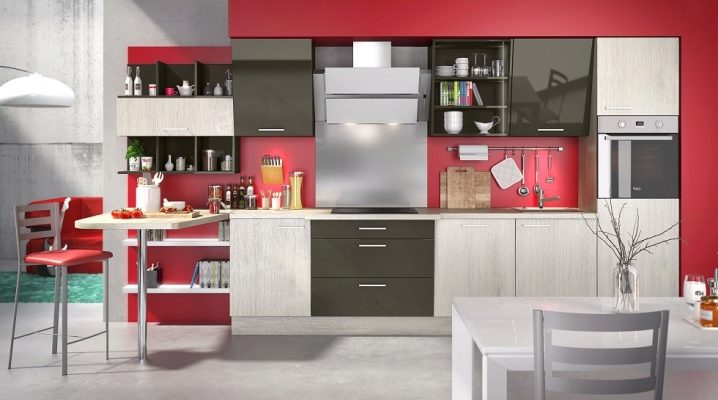
Choosing colors for decorating kitchen walls is an interesting and serious task. It depends on how attractive the interior will look as a whole, as well as how the kitchen space will stand out in the context of the style solution of the rest of the apartment or house. You cannot do without searching for beautiful and harmonious combinations, as well as design advice in this matter.
Basic selection rules
The kitchen area plays an important role in the life of the family. I want to spend time in an interior pleasing to the eye with its elegant design and pleasant color. First of all, we are talking about the color scheme for the kitchen walls. If they are decorated correctly, a good mood and tone for the whole day are guaranteed.
Experts recommend not only purchasing the materials you like for decoration, but also following the rules that will help you choose colors depending on the type of room. You will have to pay attention to several parameters: the height of the ceiling, the size and geometry of the room, the level of illumination. It is impossible to lose sight of the style in which the interior is planned to be decorated, what furniture has already been purchased for the kitchen.


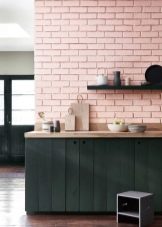

Small rooms are traditionally painted in white and light whitened colors, visually expanding the space. A lot of people love joyful and colorful hues that don't go out of style either. But you shouldn't overdo it. It will be difficult to stay in a kitchen with flashy walls for a long time - this is what psychologists say.
The darker the wall covering, the smaller the room will appear. Therefore, if you like rich green and blue, it is better to use them in a kitchen space of considerable size. And if the dimensions of the room are much larger than average, it can look dull and dull if you finish it exclusively in cold colors. It is better to add a warm and soft note to the flavor. There can be a huge number of design options.






Gamma of colors
The classic color that covers the walls in the kitchen is white. It traditionally appears in the interior and allows you not to think about combining with other elements and furniture. However, not everyone chooses the usual schemes; many owners of modern apartments want to diversify the design with fashionable shades no less. You can choose the color for decorating the walls in the kitchen in both warm and cold colors.
Colored surfaces must be painted carefully, achieving absolute uniformity of the coating. The basic rule is that when designing a kitchen interior, you need to adhere to close tones, preferably from the same color palette. It is important not to forget about the unconditional benefits of both contrasts and nuances, and single bright accents.


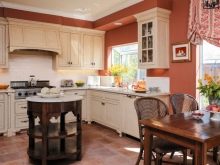
Bright
First of all, a bright tone is associated with yellow, red and pink. People always gather in the yellow interior, charged with the energy of this incredible color. All tonal varieties of sunny color evoke a feeling of warmth and comfort, increased comfort. In addition, peach and yellow shades go well enough with both close and contrasting colors - blue and lilac, burgundy and green. Gold embossing on white gives the walls a chic look.
Only one wall can be lemon, the rest can be left white or light gray. According to the rules for the decoration of premises, no more than three colors can be basic. Of these, only two are saturated and bright, the third necessarily creates a neutral background.Yellow is appropriate in all style decisions, only the classics manage with a minimal amount of this tone, replacing it with either gold accents or light sand.

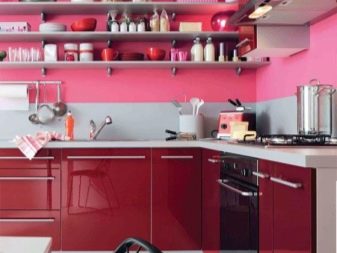



Deep blue also becomes a frequent partner of yellow, adding richness and creating a trusting atmosphere in the room. Walls of bright colors perfectly set off the fanciful furniture with patterns. Green and light green shades have gained particular popularity lately.
It is believed that the life-affirming color promotes active digestion. As the most intense of this palette, a romantic turquoise reminiscent of summer is often chosen.



Light
Pistachio shades are still the leading color choice for the kitchen. Photographs of bright kitchens with walls in sophisticated colors - olive and mint - adorn glossy magazines. Softened and warm tones are referred to as universal, since they harmoniously combine with any furniture - dark and light, classic style and ultramodern.
Beige surfaces are indispensable for creating a rustic look. Wooden furniture and brick inserts will add a cute and intimate flavor. A kitchen like this never goes out of style, and neither does natural wood floors and shelves. Beige can be easily transformed into gray and white-beige, ocher and orange.



Gray and silver tones came to us from the Scandinavian countries, where they are used everywhere. Refined tone is considered not only a symbol of comfort, but also practicality. Dust and grease are practically invisible against a neutral background, and minor shape imperfections are also concealed on it. The metal and chrome parts go well with it. Therefore, styles such as minimalism or hi-tech suggest the frequent use of grayish and light ash.
If not all shades of blue look status, metallic and pearls will immediately add sophistication to the interior. With beige and gray equal in tone in the interior, one of them needs to be strengthened towards either emphatically warm or extremely cold. This will allow you to avoid disharmony, the unpretentious monotony will be replaced by a feeling of subtle taste.



Plus, smoky gray is the perfect backdrop against which any bright spot is immediately visible. Lovers of bright furniture and bar counters will also like it. Therefore, for studio apartments and small apartments, along with white and beige, gray is often chosen.
To avoid a feeling of boredom and monotony, one should not forget that gray should be beautiful, have a non-standard shade, highlighting other colors. Then such an interior will have a beneficial effect on the psyche, you will want to be in it for a long time.


Dark
Of the dark and deep tones chosen for finishing the kitchen, I would like to mention graphite and brown. The first continues the line of dark grays, without which it is impossible to create a Gothic style. They are used in kitchens-dining rooms, where they gather for celebrations, lighting candles and crystal chandeliers.
In practice, brown is good for highlighting furniture in milky whites and ultra bright colors. Contrasting squares combining slate and white are in fashion. If we talk about the Art Nouveau style, aprons on the wall made of dark brown and almost black glass and ceramic blotches are relevant. The slate color exhibits the benefits of green, the catchiness of yellow, and the richness of burgundy.


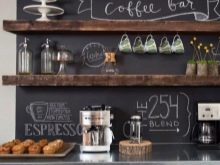
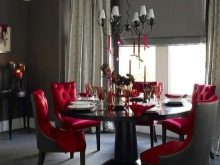

Design and accents
When choosing color and style, one should not forget about the furniture set. After all, the combination between it and the walls creates a common design ensemble. Most often, walls are painted just for furniture. The more original and pretentious the accessories, the calmer the walls should be in tone. Thus, the accents will be placed in the interior correctly.
If the set is white or very light, there is a need to highlight the walls with a brighter color, especially if the kitchen is spacious. Everything is dominated by the principle of contrast, which allows each element to draw attention to itself.So, drawings and ornaments on furniture are not combined with catchy and painted walls.


If the kitchen set is designed in a classic style and soft colors, an interesting solution would be to make the walls bright, add decor and attract attention with a large attractive pattern. The kitchen should not "get lost" in the general interior of the house.
It so happens that the furniture is still old, and repairs have already begun. It is better not to focus on the outdated headset, giving credit to the unusual wall covering. The same rule applies to insufficiently elegant and bulky furniture, albeit new. Juicy patterns and drawings on the walls will create a mood and decorate the kitchen, and the headset will not be so noticeable. In a very small room, a picture can act as a bright spot, and there should not be a lot of furniture. The walls are left in restrained and muted colors.



Designers offer their own tone solution for each wall. So, the "hog" tile is in fashion for the working area. This is a glossy rectangular ceramic. The length of the item is two to three times its width, the side edges are chamfered - hence the name of the ceramics.
They use original tiles in industrial and Scandinavian, country and loft styles. At the same time, they are connected to each other, laying out the parts of the apron in different colors - beige and burgundy, blue and mint.





Design Tips
If you choose a complex design using geometry or wall art, you can successfully use the recommendations of designers and interior artists.
- The choice of pattern depends directly on the size of the room. Large visually reduces the area of the walls, small - increases.
- The vertical or horizontal orientation of the ornament fulfills certain tasks. Vertical placement gives a sense of height and raises the ceiling. Horizontal stripes visually reduce the height, but increase the width and length.



- Diagonal patterns that create the effect of movement help to "revive" the interior. If there are overlapping Scottish-style stripes on the walls, the space will appear cohesive. This fully applies to mosaic patterns.
- Another important parameter is the texture of the coating or wallpaper on the walls of the kitchen. Texturing the walls gives the room a custom look, creating a play of halftones. When the angle of incidence of light changes, unusual color effects appear on the walls, which decorates the interior and creates an original style.
- Pure black is not recommended for use in the kitchen. It "kills" the feeling of air and space and is strongly associated with a dirty surface.



- To find out exactly which shade is right for you, hang sheets of cardboard or old wallpaper in the kitchen, painting them in your favorite colors. Some of them will want to leave, while others will soon begin to interfere with perception and annoy.
- If there is not enough light, give preference to warm colors - from peach and champagne to beige tones. Saturated shades will not work in an interior that simply floods with the sun. Bright rays change color and paint can fade. Blue and pearl shades bring the necessary harmony and comfort to the kitchen with south-facing windows.


How to choose the right wallpaper for the kitchen, see the next video.













The comment was sent successfully.